I originally delivered this essay as a craft talk for undergraduate student writers attending the 2016 James Madison University Creative Writing Conference; it has been lightly edited.
As I told those assembled, no thirty-minute talk on this subject could possibly be comprehensive. There are many ways to write weird work that matters—this piece doesn’t even begin to touch on the avant garde, for instance—and these are just a few thoughts on how to approach the problem.
Spoiler warning: This essay contains plot details for Robert Egger’s film, The Witch, and for the series finale of Buffy the Vampire Slayer, among various fairy tales and their contemporary retellings.
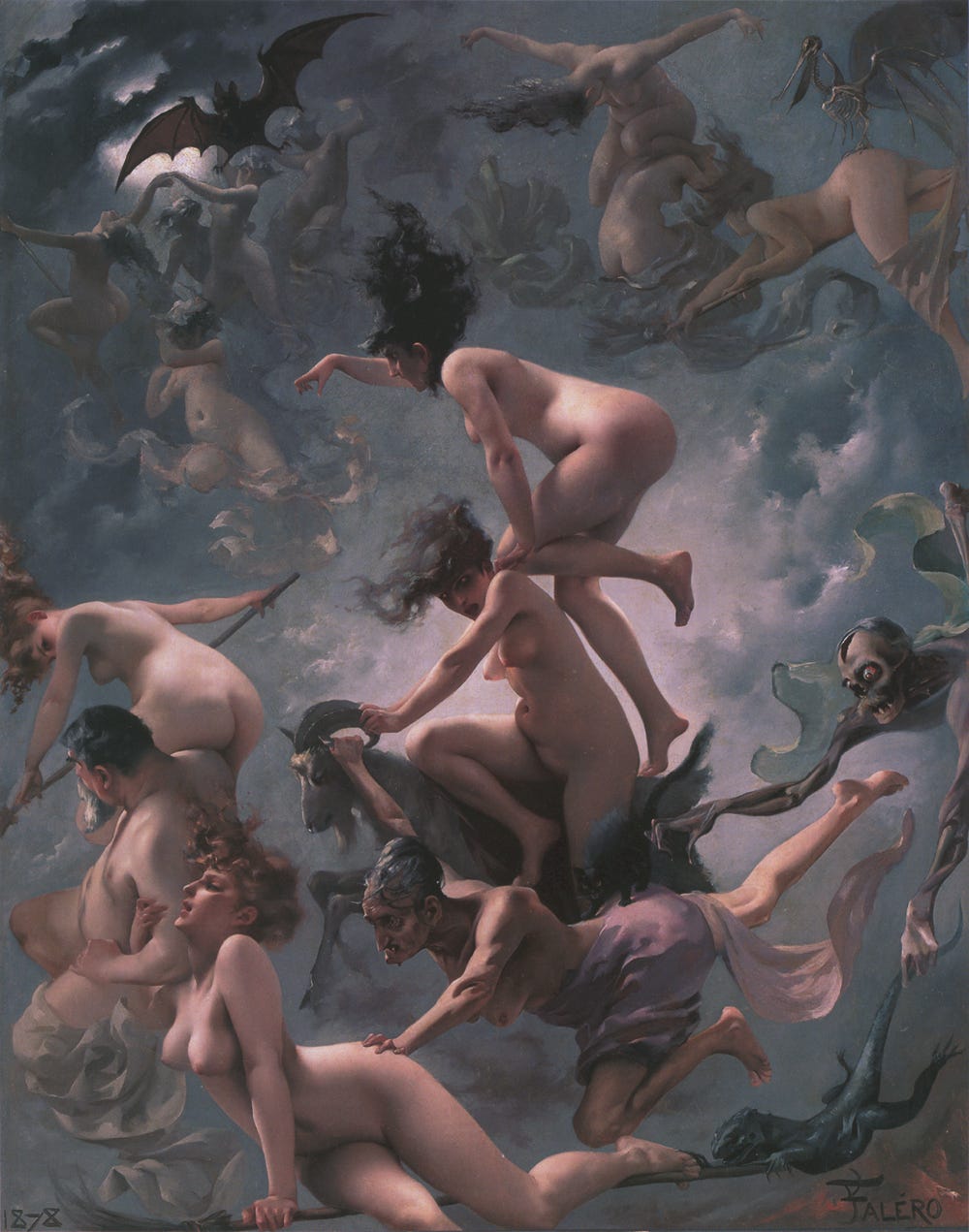
The author who served as my MFA thesis advisor is a well-respected writer of realist novels. During my first meeting with her, we sat in her office and she flipped through my manuscript with a pen in one hand and said, “Well, your writing is good, and it’s clean, but I’ll be honest: I don’t really understand what you’re trying to do here.”
If you, like me, enjoy writing stories about magical birds or vampires or spaceships, this anecdote will come as no surprise. The first meeting with any writing teacher brings a bit of apprehension. Will they get it? And for those of you still in undergrad: will they even let me write it? One of my undergraduate teachers put a moratorium on zombies during our first lesson. Another simply banned stories requiring world-building outright, believing that no short story could adequately draw a new landscape within our twelve-page submission limit. These same teachers regularly assigned stories by authors like Marquez, Barthelme, and Saunders, blithely demonstrating for us skills we weren’t allowed to practice.
There are excuses for this, of course. For instance, that we want writers to focus on psychological depth and not unfamiliar forces—as though the two are mutually exclusive, as though the Scottish Play could be written without the witches, or Odysseus could have spent nine years crossing a disgruntled but in no way supernatural sea.
Despite my protests, I do understand this impulse towards realism. In workshops, with less experienced writers, it’s often more efficient. I have read many very boring stories dressed up with ghosts or mermaids, which creatures functioned solely as disguises, obscuring the emptiness of the fiction underneath. And often, the thing missing from these works is the human heart, the bloody and beating reality that lives inside the best fairy tales, monster movies, and science fiction.
1. “Write what you know” doesn’t have to be terrible advice.
I spent my undergraduate career bristling against this advice to “write what you know,” which was often trotted out in service of denying me access to the things I wanted to explore with my writing. It took me years to realize that it could be good advice. What it really meant—when it came from my best teachers—was that whatever I wrote, there should be some piece of it that felt desperately true.
Aimee Bender’s “The Rememberer,” a short story first published by The Missouri Review and then anthologized in her collection The Girl in the Flammable Skirt, begins like this:
My lover is experiencing reverse evolution. I tell no one. I don’t know how it happened, only that one day he was my lover and the next he was some kind of ape. It’s been a month, and now he’s a sea turtle. I keep him on the counter, in a baking pan filled with saltwater.
The story is told at a remove, some months after the lover has disappeared entirely. It is, at its heart, a story about coping with the loss of a loved one, cloaked in this unnatural premise. Bender continues:
He is shedding a million years a day. I am no scientist, but this is roughly what I figured out. I went to the old biology teacher at the community college and asked him for an approximate timeline of our evolution. He was irritated at first—he wanted money. I told him I’d be happy to pay and then he cheered up quite a bit. I can hardly read his timeline, he should’ve typed it, and it turns out to be wrong. According to him, the whole process should take about a year, but from the way things are going, I think we have less than a month left.
I find this paragraph especially brilliant, because it so successfully balances real-world detail and real-world pain with the story’s premise. It grounds us in familiar details: the narrator visits her local community college to find this answer. The academic she meets there is irritable, has terrible handwriting, and is probably underpaid.
The emotions, too, are real. I read this story for the first time two years after my grandmother died of pancreatic cancer, a particularly aggressive cancer that is usually diagnosed too late for intervention, and which typically carries a prognosis of only a few months. Notice the way Bender phrases the last line of this paragraph: “I think we have less than a month left.” This is the language of terminal illness, and here it is, attached to a lover who has transformed into a turtle. Near the story’s end, the lover becomes a salamander, and our narrator can no longer watch his progression. She writes,
“This is the limit of my limits: here it is. You don’t ever know for sure where it is and then you bump against it and bam, you’re there. Because I cannot bear to look down into the water and not be able to find him at all, to search the tiny waves with a microscope lens and to locate my lover, the one-celled wonder, bloated and blind, brainless, benign, heading clear and small, like an eye-floater into nothingness.”
And isn’t this the scariest thing about terminal illnesses? We fear the moment when the person we love disappears — either through death or delusion.
At the end, the narrator drives her lover and the pan of water to the seaside and releases him into the ocean. She keeps an eye on the papers, in case a confused, naked man washes ashore somewhere else. She makes sure her phone number is listed, so he could find her again. In the cycle of grief, this is acceptance tinged with denial, or with hope, depending on your perspective.
What could be more relatable? Of course, you could elicit this with, say, a cancer story. But how many stories have you read about cancer? And how many have you read about de-evolution?
* * *

It’s a cliché to say that fairy tales endure because they teach timeless stories, but like every cliché, there’s something true in it. Throughout history, the stories of folk have been those that need telling for a society’s survival. They teach our children the lessons we wish them to carry out into the world. They are products of their historical origins as much as they help to shape the coming futures.
In her collection, The Classic Fairy Tales, Maria Tatar anthologizes various tellings of popular stories alongside scholarly essays and interpretations. You see the regional differences immediately: in English tellings, Little Red Riding Hood usually carries soup or honey for her ailing grandmother, but in an Italian version collected by Italo Calvino, her basket is full of lasagna. And depending on whose version you read, Little Red Riding Hood is a story about a girl who can’t follow direction, a story about sexual assault, or a story about sexual awakening—or it might have a different moral entirely. James Thurbur’s version, written in 1939, ends like this:
She had approached no nearer than twenty-five feet from the bed when she saw that it was not her grandmother but the wolf, for even in a nightcap a wolf does not look any more like your grandmother than the Metro-Goldwyn lion looks like Calvin Coolidge. So the little girl took an automatic out of her basket and shot the wolf dead.
Moral: It is not so easy to fool little girls as it used to be.
Thurber is being a smartass, of course, but this does bring us to an important point: fairy tales can be reimagined to present-day relevance and still be fairy tales.
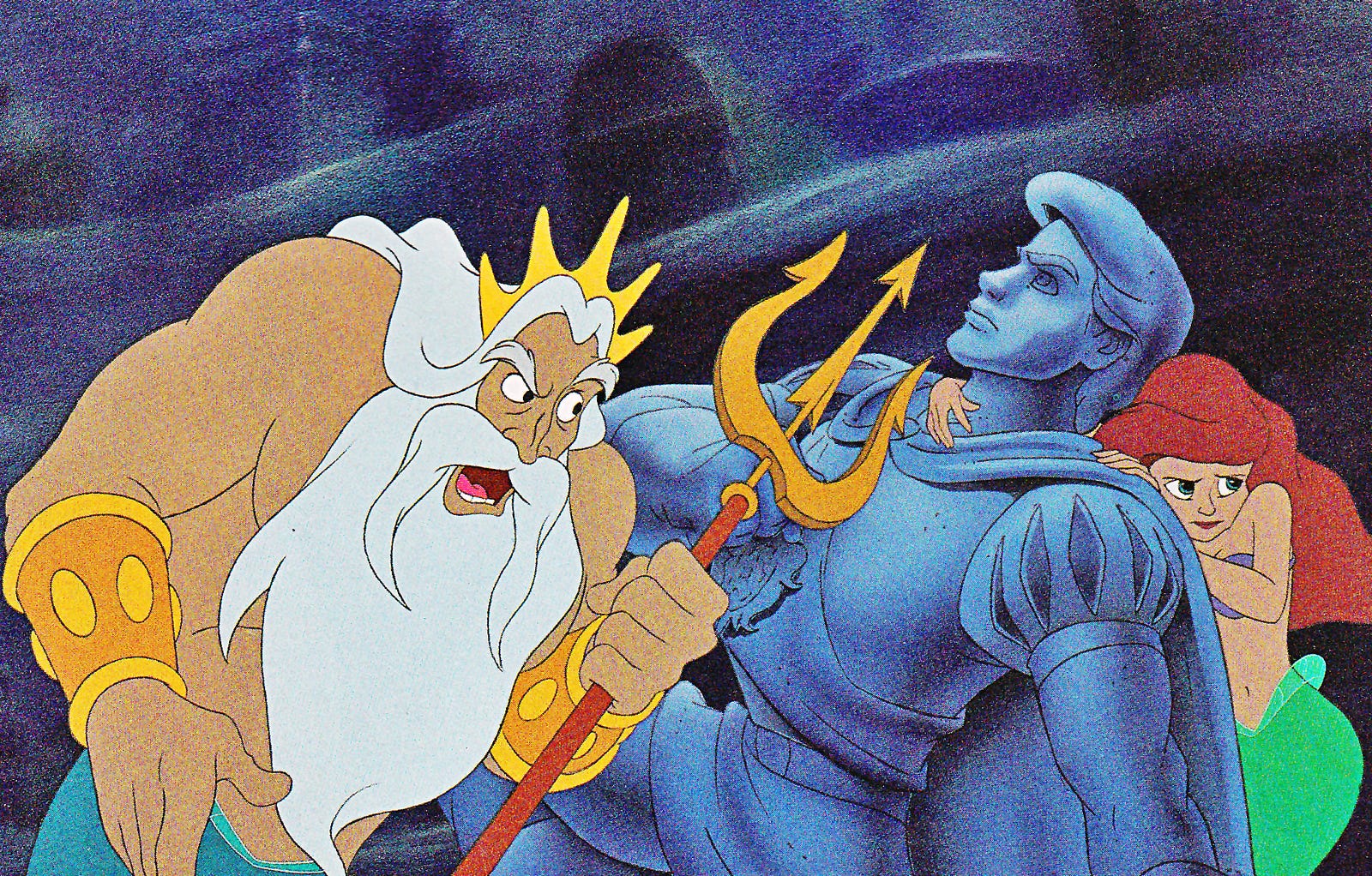
Feminist geek blog The Mary Sue recently ran a piece entitled “Queer Subtext in The Little Mermaid, From Hans Christian Andersen’s Original to Disney’s Adaptation.” The article is worth a read in its entirety, but I’ll pull just a few points here.
Historians are now largely agreed that Andersen may have had a romantic relationship with another man, a young Duke who was under pressure from his family to marry a princess. This obligation finds its way into Andersen’s Little Mermaid with the figure of the prince, who ultimately does marry a human princess, not the mermaid who loves him. Heartbroken, the mermaid throws herself into the sea and melts into foam.
Disney’s version preserves this history. The lyricist for the film was a gay man named Howard Ashman, who died of AIDS in 1991. Ashman was closely involved with many aspects of production of the film, and reading it as an explicitly queer allegory reveals scenes common to many queer coming-of-age narratives. Ariel’s father, King Triton, begs her to be “normal,” to forget her obsession with a different world. Rather than attempting to understand her fascination, he destroys her treasures from the land, claiming that he wants to protect her. Ariel flees her home—something sadly not unfamiliar to the estimated forty percent of homeless youth who identify as LGBTQ. Happily, the movie ends with King Triton accepting his daughter’s wishes—and painting a rainbow across the sky to celebrate her wedding day.
Howard Ashman also worked on Beauty and the Beast in the late stages of his illness, until his death. It’s a film that gets knocked around sometimes in favor of a cheap joke about Stockholm Syndrome, but composer Alan Menken has called it Ashman’s “personal story.”
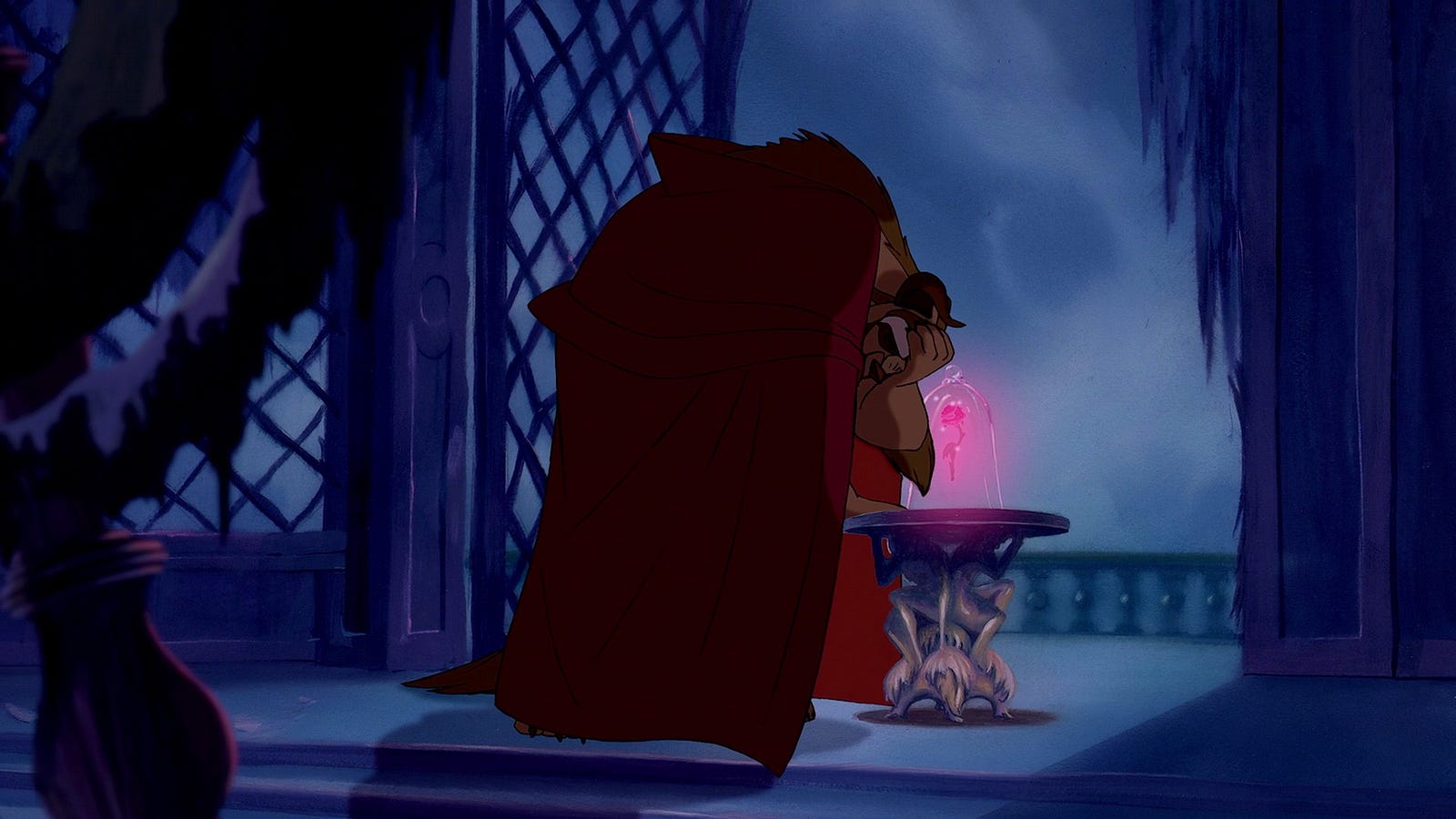
Writes Akash Nikolas for The Atlantic, “The result is a movie that can be viewed as an allegory: Shunned from society, his body hideously transformed, and his life wilting away like the enchanted rose, the Beast is a figure of degenerative disease. . . . Belle’s love and the ultimate breaking of the curse is the fantasy cure that Ashman was denied.” And surely, the film’s final scene where the servants are returned to their human forms, where loved ones are restored, means something just a little different to an auteur living at the height of the AIDS crisis, when so many people were lost.
Similarly, 2013’s Frozen has resonated deeply with many viewers who see Queen Elsa’s struggle as an allegory for closeted homosexuality, which has sparked a hashtag and petitions to the Disney corporation to make her sexuality explicit in the film’s coming sequel. But the film has also resonated deeply with many viewers living with trauma or mental illness, who see their own struggles reflected in Elsa’s arc. In May of 2014, a viral video made the rounds of the internet, showing a group of US Marines enthusiastically singing along to the film’s break-out number, “Let It Go.” Most of the coverage played it for laughs, a fun scene to share with civilians. But if you read Frozen as an allegory for fighting with and healing from trauma, this moment of Elsa’s liberation isn’t just about the way she lets her hair down and shows some thigh. It likely reads very differently to a population whose suicide rate is fourteen times that of the overall American average.
It goes without saying, of course, that most viewers won’t search these films too far beyond their surface plots, but that doesn’t mean that the desires for love, acceptance, and safety expressed by these stories aren’t common to all of us, and that they can’t resonate particularly strongly with groups of people in need of their comfort. They are meaningful whether we think through hidden authorial intent or not. The Beast hiding alone in his tower speaks volumes about the people who have forced him into exile, and, in Ashman’s context, about our own world in 1991. This brings us to the next point:
2. You can learn a lot about a society by studying its monsters.
Until his retirement a few years ago, the University of Virginia employed a vampirologist. His name is Professor Jan Perkowski, and he has traveled the world collecting vampire lore. For many years, he taught a course at UVA called “Dracula,” which examined the figure of the vampire through folklore, literature, and pop culture.

In his own research, Perkowski has traced the significance of the pop culture vampire to place the creature in its appropriate context, and what he found was a mirror of the cultural values that dominate a story’s origins. Two examples:
Classic Hollywood horrors, produced at a time of global anxiety and heightened xenophobia during the Great Depression, often feature monsters that come from exotic locales. Bela Lugosi’s Count Dracula, brought to the screen in 1931, is foreign above all else. Fortunately for the world of the film, there are experts like Dr. Van Helsing, who have the particular knowledge to save humanity from this outside threats, and to guide the audience through cathartic release.
Later, in the 1970s, the MPAA began to relax its restrictions on sex and blood in the movies, largely in response to the liberalizing trend of the era. In turn, vampire movies got bloodier, but also sexier. Check out Frank Langella’s 1979 Dracula in the top right corner, his shirt unbuttoned, his arms open and inviting. In its review of the film, The New York Times wrote, “Mr. Langella is playing Dracula as the compleat ladykiller, a dashing and romantic figure who just happens to have one little kink.”

Today, witches are having a bit of a moment. Robert Egger’s film, The Witch, subtitled “A New-England Folk Tale” brings puritan fears of witchcraft to the screen, but twists them for a modern audience. Though the bloodiest deeds occur at the hands of an old crone lurking in the woods, the viewer is led to consider that true terror is inflicted on the young female protagonist, Thomasin, by her family, who suspect her of congress with the devil. The film was widely praised in feminist circles for its ending, where our hero rejects the Christian patriarchy and embraces Satan, literally ascending to darkness into the film’s final, ecstatic sequence.
As The Witch saw its nationwide debut, Broadway launched a revival of Arthur Miller’s The Crucible, the tale of the Salem Witch trials he famously penned to parallel Joe McCarthy’s HUAC hearings. The real villains of Miller’s play are the righteous judges who refuse to see any reason that challenges their desire to do battle with the occult (i.e., communism), and this 2016 revival spares them no sympathy. But I found it interesting, watching the show from my high-up balcony seat, that the director had chosen to stage his play in a school house, and had clothed the accusers in schoolgirls’ uniforms. Miller’s character are older than the real “afflicted girls” of Salem village, but this costuming firmly decides that they are girls.
A few weeks before I attended the production, The Establishment ran an article titled, “Why Are We So Scared of Teenage Girls?” The piece opens with this quote from a psychologist: “I’d rather do anything than treat teenage girls.”
The article continues,
He said that teenage girls couldn’t be trusted, that they would pretend to be your friend and then stab you in the back, even if you were their shrink. There was something about the teenage girl that was just too much, seductive and repulsive all at once. They were beyond the understanding of medical science, even, as if their angst defied the laws of physics and chemistry. This doctor was prepared for cadavers and psychotic breaks, but not for the teenage girl.
Fiction, I find, is ultimately about fear. Fear of loss, fear of rejection, fear of the unknown. Our monsters can be all of these at once, hulking in the dark or pointing fingers across a court room. In what may be my favorite essay published last year, a piece called “Who is it that Afflicts You?” on the queer women’s blog Autostraddle, the author writes about the malicious witchcraft of today’s world:
The point, I guess for me, is my friend’s rapist who saw virtually zero repercussions despite video evidence showing what he did to her; “experts” claiming that the death of Tamir Rice was “reasonable” on the part of the police officer who shot him. If that isn’t evidence of supernatural power—the power of whiteness, the power of male privilege, the power of state authority, the power of rape culture—at least as much as Cotton Mather finding a “witch mark” on someone’s scared and shaking body, what is? . . . I’m thinking of how many major names and national leaders are products of secret societies, Skull and Bones or Scroll and Key, what have you. These are men (and they are all men) who we know essentially for sure crept around in crypts having solemn ceremonies and laying down in coffins to later be inducted into immense power, and have for generations — yet it’s feminists that Pat Robertson famously claimed practiced witchcraft.
And if that power can be harnessed, if we are made into monsters but can reclaim witchcraft and take it back, why shouldn’t we? Why wouldn’t we want to? Feminists are now resurrecting the folkloric witch, writing her into their stories or bringing her into their faiths—and both can be paths to transcendence. And so, to that end:
3. Seek out the balance of beloved genre tropes and new ideas. What needs an upgrade? What can you freshen with a twist?
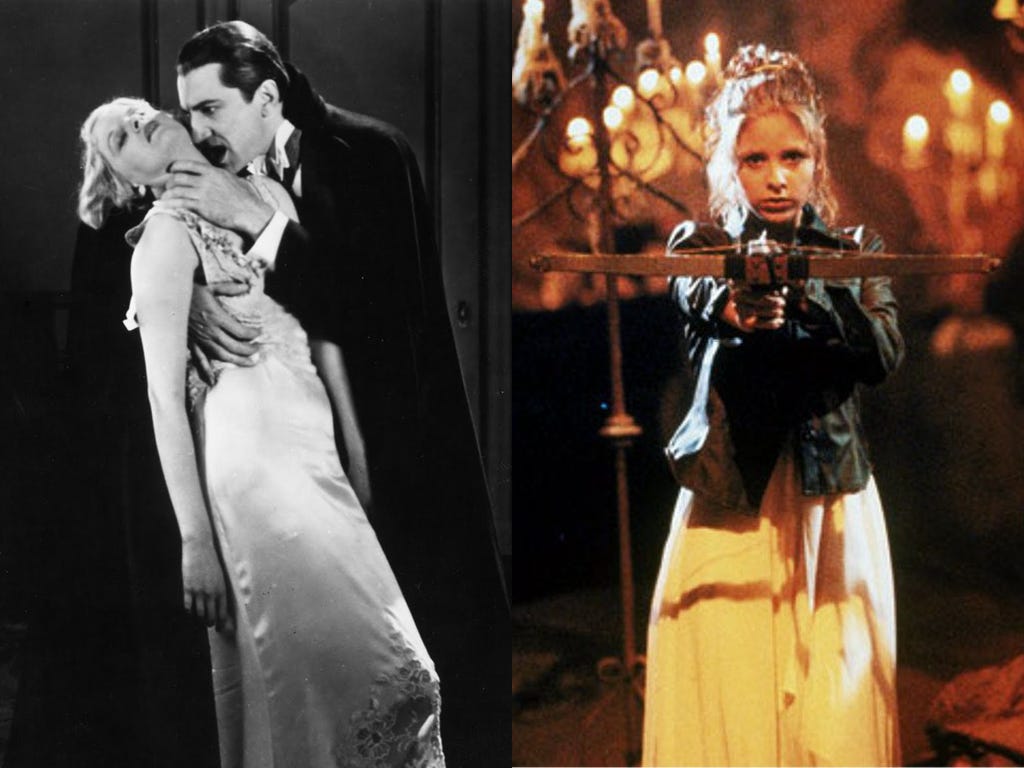
The image on the left here is from the 1931 Dracula: Mina Murray at the mercy of Lugosi’s dark Count. (The tragedy for me is that Mina is actually one of the smartest characters in Bram Stoker’s novel, but because she is a woman in 1897, her powers are limited, and she is reduced to damseling.) Compare to the image on the right. In 1997, amid the pop culture girl power explosion, Joss Whedon took the slight, feminine, blonde damsel in distress and made her the hero young women needed and deserved: Our Lady of the Hellmouth, Buffy Summers. Whedon has always been explicit about the fact that he wanted Buffy to be traditionally feminine in order to cut against those tropes. She is a cheerleader; she likes shopping and make-up and going on dates with boys.
In the first season of Buffy the Vampire Slayer, Buffy faces a very old vampire, one heavily influenced by ritual and and ancient values. She goes to meet him carrying a crossbow and wearing a leather jacket over a white, wedding-esque prom dress, the sort you see on debutants and virginal brides. Not to get too English major-y with this, but when Buffy defeats this very old vampire, it’s hard not to see her impaling the patriarchy on a giant spike. (And then, for good measure, she smashes its bones to pieces with a sledgehammer in the second season premiere.)
The world of Buffy is heavily bound up in lore. In early episodes, the opening sequence intones the story of one girl in every generation, one girl in all the world, who alone has been chosen to fight the forces of evil. Buffy, in typical hero’s journey fashion, spends much of the show trying to reject this call of duty, trying to break from obligations she never chose.
In later seasons, she travels into the desert to perform a ritual that will impart to her knowledge of the very first vampire slayer. She learns how the very first vampire slayer was made: a group of men kidnapped a girl. They stripped her of her agency, chained her to the earth, and violated her—forced a demon inside of her to make her a warrior, and bend her to their own purposes. The lineage of the slayer has obeyed the rules set by these men ever since.
At the series’ end, Buffy has accepted her role as protector, but in one of the best twists in television history, she and a group of women stand up and declare that they will no longer play by these rules set by men. They blow the rules apart, and return agency to the women of the slayer line. They give themselves a choice that has been long denied.
Tell me this isn’t a fantasy of feminist triumph over the institutions of the patriarchy. It’s a powerful commentary on writing outside the rules, whether you applaud the message or not, and it demonstrates the best ways in which writing the weird can work: when both the story and its real-world implications are strong, and they feed into each other to grow stronger.
4. Even a story that takes place in a far-off world will be read in this one.
On to the realm of science fiction: a new Star Trek series is in the works. A title treatment for it popped up on YouTube a few weeks ago. Just some zooming through space, some music, a series logo. Basically nothing. But this is the internet, so people started forming very strong opinions immediately—it totally hit the right tone! it totally hit the wrong tone! And one commenter said this: “I’ll watch as long as there’s none of that PC bullshit.”
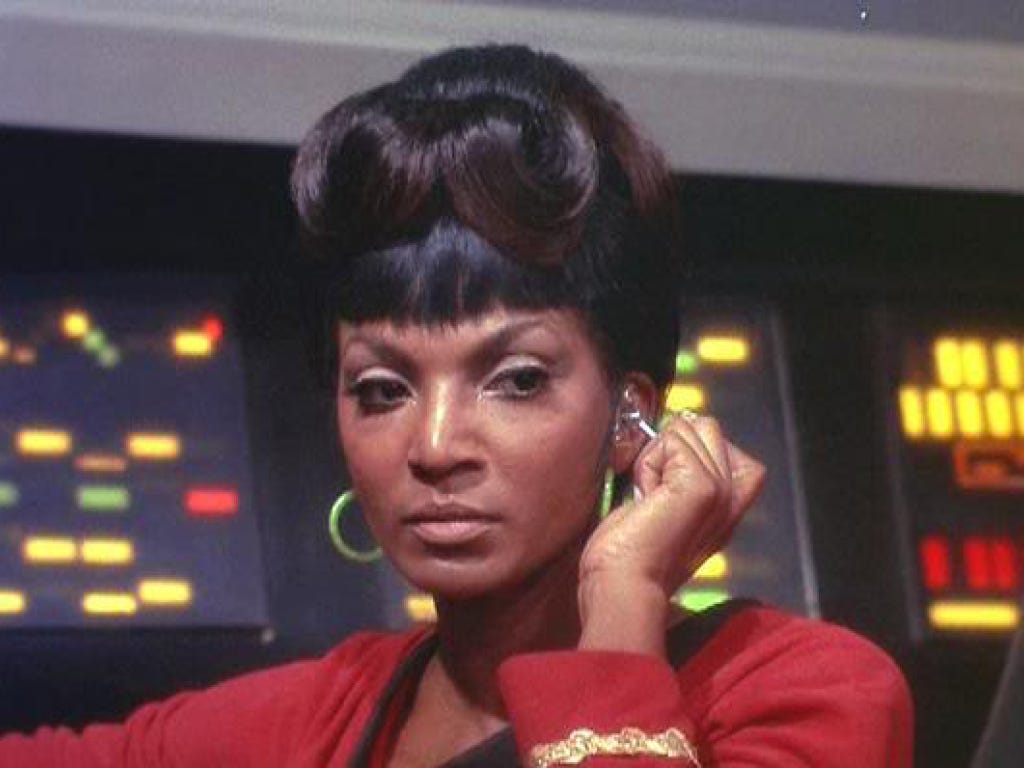
I made that face. And then my first coherent thought was, Oh. You must be new here.
The woman above is Nichelle Nichols, who played Lt. Uhura in Star Trek: The Original Series from from 1966 to 1969. If you ask hardcore fans of the franchise what they love about Star Trek, their answer will likely have less to do with spaceships than it will with the show’s thoughtful vision of an egalitarian, progressive world. Nichols recounts in interviews how she was planning to leave the series after the first season of the show. She had an opportunity to perform on Broadway and intended to take it. The person who convinced her otherwise was Dr. Martin Luther King, Jr. He met her and told her how important the work she was doing truly was, that she was a vital symbol in the cultural landscape, that Star Trek was the only show he would allow his children to stay up and watch. It was groundbreaking, he reminded her, that a black woman could appear on television in an equal role, and the movement needed her there.
Much of science fiction is grim about our prospects of getting out of this next millennium alive, but Star Trek provided a utopian vision, which is not to say a dull one. Science fiction can do this—it can show us those things like racial and sexual equality that don’t exist in our world but should.
And to that end: “But it happens in another world!” is a poor excuse for bad world building or shallow emotions. Your plot may be in another world, but your readers are in this one, and they will come to the work with their own experiences foremost in their minds.
But, if all of this is starting to sound like a lot of pressure to put on a simple story, don’t forget:
5. You don’t have to start with a Big Important Message, as long as some humanity comes out of weirdness.
One of my favorites of my own stories is a strange piece about storks and my native Bulgaria. When that story came to me at first, all I knew was that I wanted to write about the disappearing birds. I had been to the Bulgarian village that inspired fictional Kokoshevo, and I was fascinated by the idea that so many of the visitors to this place stopped in order to witness what felt like a profoundly symbolic migration.
The politics were present in the first draft, but so muted that a member of my cohort called me out in workshop for writing exactly the kind of empty weirdness I’ve been cautioning against this whole time. He was right; it needed more depth, and so I worked to pull the story of my struggling motherland into the piece, began the careful balancing act of giving just enough, of trusting my reader to understand without needing to be told too many times, and overwhelming them with too much.
Remember that you don’t have to start with the heavy stuff right away. If it would slow you down, don’t worry about it in the first draft. Instead, do what you always do: throw words around, see what ideas stick. Write those, and delight in their strangeness.
But then, after—take a step back, and consider why this plot excites you. Beyond the witchcraft and sea monsters and legends, what does it mean to you? Where does it hurt and how does it liberate you? Think of your readers: fellow human beings, separate and unique, who can come together through poetry and narrative. Where does your work unite us, as folk? Linger there. Find those places where lore matters, and dig in deep.
